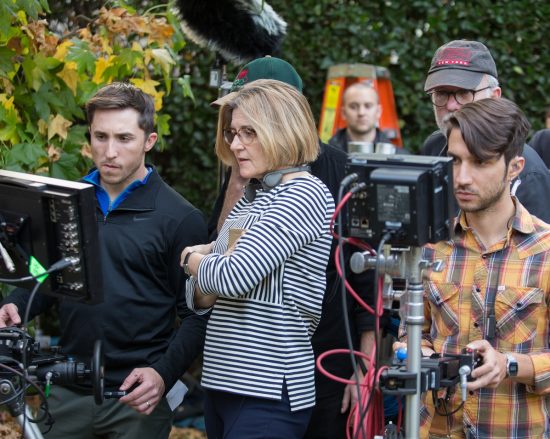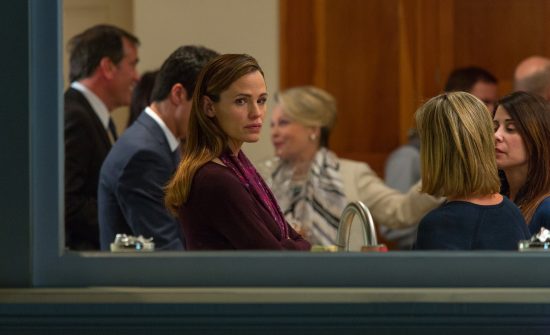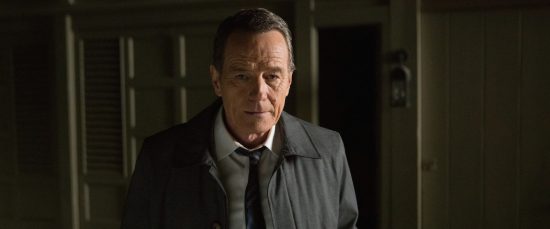Wakefield – Robin Swicord on writing and directing the new Bryan Cranston film
Strikingly original drama Wakefield – starring Bryan Cranston – is out on DVD July 31st, and is written and directed by Robin Swicord.
Robin has been working in the film industry for many years, including on films such as Matilda – which she co-produced – and Memoirs of a Geisha and The Curious Case of Benjamin Button, both of which she helped write for the big screen. After directing her first feature film The Jane Austen Book Club in 2007, Robin returns with the equally impressive Wakefield – which continues her reputation as a fascinating filmmaker and a shining light for female directors everywhere.
Have you ever just wanted to walk away from it all? And how would your friends and family cope in your absence if you did? Those questions and more are asked in the strikingly original Wakefield.
Successful suburbanite Howard Wakefield (Bryan Cranston; Breaking Bad, Trumbo) takes a surprising detour from family life when it all starts to get too much: He vanishes without a trace. Hidden in the attic of his carriage house garage, surviving by scavenging at night, Howard secretly observes the lives of his wife, his children and his neighbours as they learn to live with his unexplained disappearance. But has he left his family, or has he left himself?
A fraught meditation on marriage and identity, Wakefield features a tour de force performance from a never better Cranston in a film that won wide praise following its debut last year at the Toronto International Film Festival. Based on a short story from the legendary American novelist E.L Doctorow and brought to the screen by acclaimed writer/director Robin Swicord (The Jane Austen Book Club, Memoirs Of A Geisha), Wakefield features supporting performances from Jennifer Garner (Dallas Buyer’s Club, Juno), Beverley D’Angelo (Entourage, Cougar Town) and Jason O’Mara (The Good Wife, Marvel’s Agents Of SHIELD), but make no mistake – this is Cranston’s film, featuring a truly towering performance from one of the most important actors working in film today.
Live for Films recently caught up with Robin to discuss the secret to writing a great adaptation, directing Bryan Cranston and – of course – which movie monster she would like to be killed by.
Hi Robin. Thanks for taking the time to answer some questions for us at Live for Films today. You have written the screenplays for films like Little Women, Matilda and Memoirs of a Geisha – what is the secret to a great adaptation?
The adaptations that I love carry a sense of the tone of the original novel or short story; and hew closely to the intentions of the original author. A reader who loves a certain book is sensitive to the “personal qualities” of that book. Dramatists necessarily must compress or expand on certain moments, and combine scenes to create a dramatic narrative of much shorter length. The audience forgives these liberties if they feel a sense of recognition when watching the film.
Did you always want to be a director? Is it something that you have always been working towards, or a role that only recently started to appeal?
I have wanted to both write and direct film, since I first discovered in my late teens that films had writers and directors. When I sold my first screenplay in 1980, I was 27 years old; and I had no idea that a female filmmaker was a rare-to-unseen creature in Hollywood. From my first studio meeting onward, I began lobbying to direct my own work. It took a couple of decades of efforts toward that, before the idea of a female writer-director no longer seemed radical.
How did you get attached to Wakefield, and what was it that made you want to direct this one?
When I read the short story in the New Yorker in 2008, I knew the story had the potential to be an unusual and fascinating film. A producer Elliott Webb and I approached the author E.L. Doctorow and persuaded him to let me borrow the short story for a while. I wrote the screenplay on spec in 2012. With producers Julie Lynn and Bonnie Curtis, we set out to convince Bryan Cranston to play the role of Howard Wakefield. We had to wait for Bryan to finish shooting other projects; during that time my producers raised independent financing. A few weeks before shooting started, we attracted Jennifer Garner to the project. Everyone worked for scale. I gave back my directing salary so we’d have the money to build the attic set. We shot the film in 20 days on a small budget.
I wanted to direct the film because it offered me truly unique challenges, creatively. I had always been told that novels were “internal;” and that movies were more about visual spectacle. I didn’t feel that was true – I have felt the “internal” nature of filmmaking many times, through a great actor’s performance. So I took up the challenge of trying to photograph the inner journey.
What is your directing style? How do you approach directing actors?
I listen and nurture, and try to use my intuition about people. I ask actors directly, “How do you like to work?” and then I find a way to use their process as we begin to work together. On set I am quiet and watchful; I hire carefully, and then I trust the people I hire. I don’t micromanage. I like to work in an atmosphere of trust and respect. It’s an efficient way to work, and it makes for a productive, happy crew of artists.
How did you find working with Bryan Cranston and Jennifer Garner on Wakefield, and how did you go about constructing their characters and moulding their performances with them?
Bryan Cranston is a writer himself (as well as a producer and director). He is text-oriented as an actor, so our process was largely one of going very slowly and carefully through the script, looking at every moment, line and image, while Bryan explored aloud the meaning and opportunity in every page. This is how he takes the character under his skin, and prepares for the work ahead on set.
What he needed from me while we were shooting was a light presence off-camera. I would set the scene in context – “Before this you were scavenging in the street; and you’ve just had the good luck to bring home a futon you found on the street – the first comfortable bed you’ve been near in about 6 weeks”; and a when it was relevant, I’d tell him what was coming up: ”You aren’t upset here, you’re just wary; you don’t realize yet how dangerous these gleaners are.” Occasionally I would ask for something specific: “I think he could be very still here.” Bryan is an inventive, creative actor, and I shot his scenes as often as possible with two cameras simultaneously, with different size lenses, so that Bryan would have the freedom to throw in a moment or a line, and I could shape a final performance in the editing room. It allowed Bryan to be playful and “in the moment”; and he trusted that I would be able to see the coherent performance in the editing room. On our time frame, multiple takes on set were rare. When I saw that we had what we needed for the performance, I would move on.
Jennifer Garner is also a complete joy. She is a gifted actress, and comes to set incredibly prepared. She had direct, intelligent questions for the writer-director; she’s quite sensitive to the emotional through-line for her character. Like Bryan, Jen explores in a playful way, yet she grounds every moment in truth. I wrote a separate script for the life that goes on in the house, giving Jennifer and the young actors who play the Wakefields’ daughters specific scenes and actions, character arcs and relationships. What we’re watching from Wakefield’s attic window isn’t three actors vamping. They have a separate movie going on behind that window glass. Jennifer loved being freed from hitting certain camera marks in her blocking, and having to think about where the camera is, and having to keep exact continuity – the “Which hand was I using to pick up the tray?” stuff that can throw you out of that happy sense of play-acting. She and Ellery and Victoria simply made a family together in the house, and lived it authentically in front of our voyeuristic eyes.
Bryan and Jennifer and I set aside one very special rehearsal in which they made their marriage together. We did guided intimacy exercises which helped them break down the social barriers that all of us feel in proximity to people we don’t know well. One of my pet peeves: To be watching TV or a movie, and see actors who have clearly just met each other ten minutes ago having to try and force a sense of a deep relationship as their characters. I feel for the actors, in that case; but I also resent that we’re being asked to believe in something that clearly isn’t real. Bryan and Jen and I did important work together in that intimacy rehearsal, and the actors drew on that throughout production.
Were their any particularly challenging aspects to making the film?
It isn’t easy to make any feature film in only 20 days. There’s an incriminating production photo of me, our DoP and the First A.D. sitting in the only tiny trailer we had, after a 16-hour shooting day, having to endure one of our nightly production meetings with the producers in which we problem solved for the next shooting day – a day that would start in about 7 hours. We look like three corpses that have been propped on a bench.
Is there a scene or moment that you are particularly proud of, or that you had been really looking forward to realising?
What I mostly feel is relief that we actually made the film we set out to make, and that it has found its way to audiences.
Was it exciting to be making the film on the Universal backlot?
We shot for 1 night on the Universal back lot. Every night scene in the film in which you see Howard Wakefield walking (or running) past suburban houses was shot in one 12-hour night on the Universal “suburbs” set – which is about 2 blocks long. The rest of the film was shot in or near Pasadena. We had two location houses. Wakefield’s kitchen window was in South Pasadena, where we shot for 2 days. We shot the rest of the house scenes in Pasadena, in a house we had for about a week. The attic set was constructed on a sound stage in Riverside Studios (which also had standing sets for New York Bar and New York Apartment); we shot the New York commuter train in Griffith Park, at the “Travel Town” children’s museum.
If you could remake any film, which would it be and why?
I’d like to remake “Notorious” – not because anyone could improve upon that brilliant film, but because the problem that protagonist Alicia Huberman faces still feels very contemporary and relatable to me, and to many of my contemporaries: It’s the story of a fully capable young woman who rises to the work that’s placed in front of her, and yet finds herself being objectified and treated without respect by the men who have sent her in to do the job. Her immediate supervisor sexually harasses her and draws her into a love affair; later he allows his feelings for her to cloud his judgment. Meanwhile, Alicia’s suggestions and warnings about the dangers she faces at work go ignored, and in the end, she is left unprotected to take care of the important mission herself. I’d love to re-imagine this film in a contemporary setting. It could become an “anthem” movie for today’s female audience.
Our last question is an odd one – but we ask it of everybody we interview for the site… If you had to be killed by any movie monster, which one would it be and what would your last words be?
I’d like to die quickly and unexpectedly without drama. Maybe Godzilla could step on me? My last words would be: “Hmm, what’s that shadow?”
Wakefield is available on digital platforms from the 28th of July and on DVD on July the 31st.













